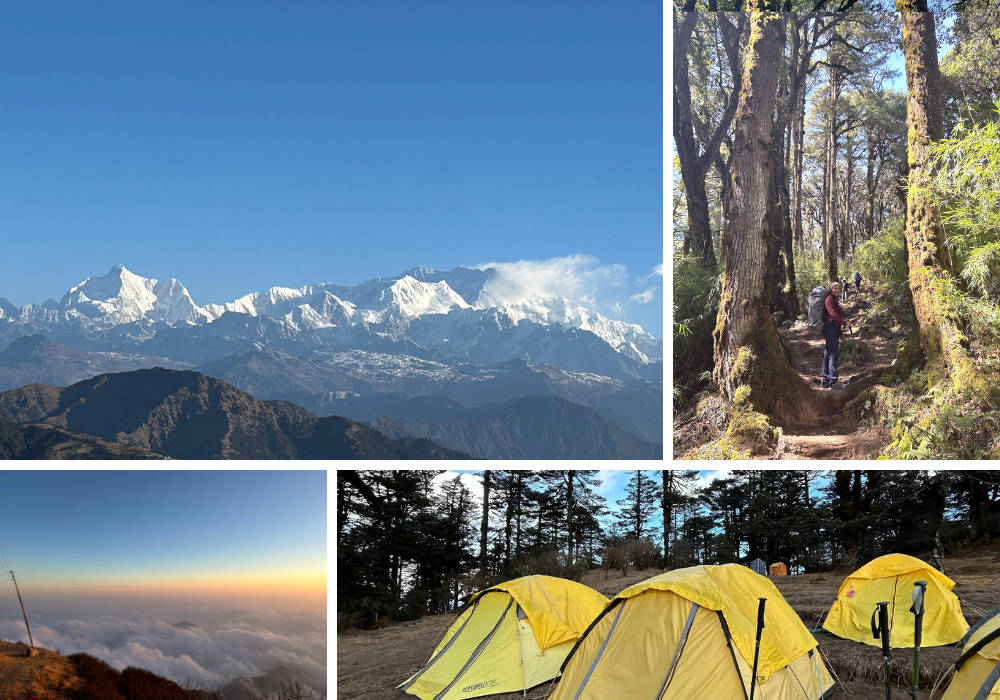After 10 years, I agreed to go on another Himalayan trek with my husband. I did it for him. Shailesh—his name also means Lord of the Mountains.
He is the quintessential trekking aficionado in our family—our mountain man—having got several treks under his belt now.
Trekking was never my scene of choice. I’m an outdoor person, but the ocean is what pulls me.
For a long time, I hadn’t really put myself through any physical discomfort. In late December 2023, I signed up for the Sandakphu Phalut trek. I agreed to push myself, start to cycle 30km in 45 minutes for a few weeks leading to the trek because I’m not a fan of running (as yet!), rejig my mindset and do something selfless for someone because it really means the world to them.
Sandakphu had been on my husband’s bucket list for a while. His goal is getting as close to Mt Everest as he possibly can. He even attempted the Everest Basecamp trek but had to return due to sudden health concerns while there. For me personally, I never imagined myself physically capable of undertaking a feat of this magnitude. Somehow I talked myself into Sandakphu thinking it was apt for my level of fitness! One factor that helped me say yes was the fact that one of our closest friends was joining us on the trek. Having two known people on this type of a trek is a nice security blanket for the times you’re unsure of whether this is right for you! The glowing reviews of the trek from the founder of IndiaHikes only helped make my decision stronger.
Sandakphu in 2024—my first shot at seeing the entire Sleeping Budhha range up close! Wow. The closest I’d ever been to these peaks was way back in the mid 90s on a trip to Nepal with my parents. We had boarded Royal Nepal airlines special 40 minute flight to catch the peaks from midair.
Why Sandakphu Phalut?
There is nothing else like the Sandakphu Phalut Trek. It offers the breathtaking experience of seeing three of the world's tallest peaks. The Sandakphu Phalut trek starts at an altitude of 6,400 ft and climbs to 11,930 ft. Even if the altitude in itself might not seem impressive, what makes Sandakphu special is the mighty mountain ranges and peaks that you get to view on the trek. The steepest climb is on the first day taking you to 9,450 ft, giving you a 3,000 ft height gain. Reading about the height of the tallest peaks just doesn't do justice to the actual height!

[From Phalut, on your left is the Everest cluster, which includes the world's fourth- and fifth-highest mountains, Lhotse and Makalu.]
Of the seven Himalayan Ranges, (Karakoram, Punjab, Garhwal, Kumaon, Nepal, Purvanchal and Sikkim) you trek through three of the ranges (Nepal, Purvanchal and Sikkim). Moreover, you’ll also get to view three of the highest mountains in each of these ranges—Everest in Nepal, Kanchenjunga in Sikkim and Choma Lahuri in Purvanchal.
This is what makes Sandakphu an extremely special trek.
It's a once-in-a-lifetime chance to see these three majestic peaks together from a vantage point.

[Woke up at 4 a.m. to watch probably one of the best sunrises I’ve ever seen! The Sleeping Buddha range is in the background.]
The "Sleeping Buddha" on your right is even more impressive. The resemblance of the massif to a sleeping human form is uncanny. The third-highest mountain in the world, Kanchenjunga, stands out as the most prominent peak in this uniquely shaped massif.
We woke to the Sleeping Buddha from our Sabargram campsite.

[Campsite #1 at Molley. It was really cold that night! Not to mention windy too.]

[The entire loop of the trek starting from Sepi basecamp.]
Still curious about what each day looked like?
Here’s what you can expect in the week that you’re there.
Day 1: Drive from NJP / Bagdogra to Sepi Base Camp (130 km/7 hours)|
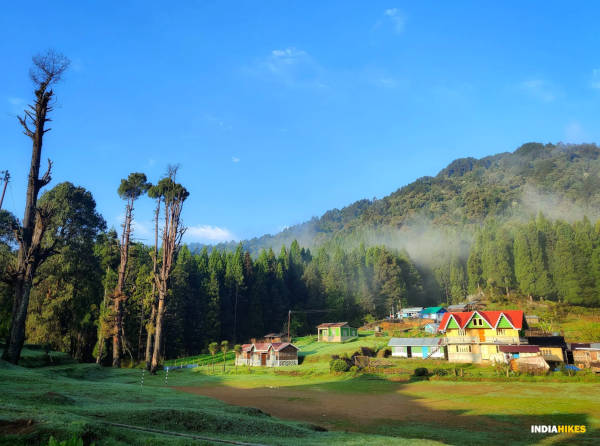
[Homes along the Sepi village. Courtesy IndiaHikes.]
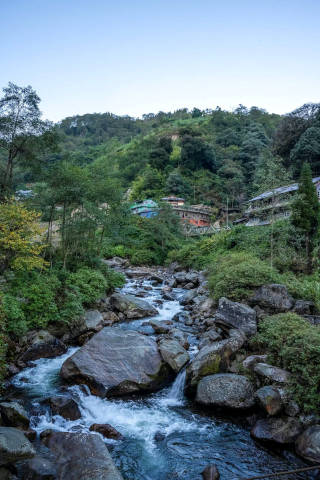
[Water. A very precious commodity up in these regions]
Day 2: Trek from Sepi to Samanden (14 km / 7-8 hours; altitude gain: 6,400 ft to 7,760 ft)

[Ascent days, enroute to Samanden. Samamden literally means “the Golden Plate”]
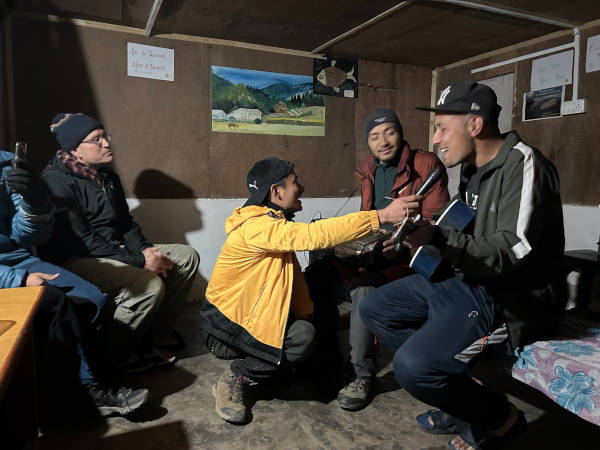
[Rupesh, the owner of this teahouse, enthralling us with his Nepali songs. He also sang Happy Birthday for one of our group members. The orange sooji birthday cake was a welcome surprise for her and well, us too!]
Day 3: Trek from Samanden to Molley (10 km / 7 hours; altitude gain: 7,760 ft to 11,220 ft)
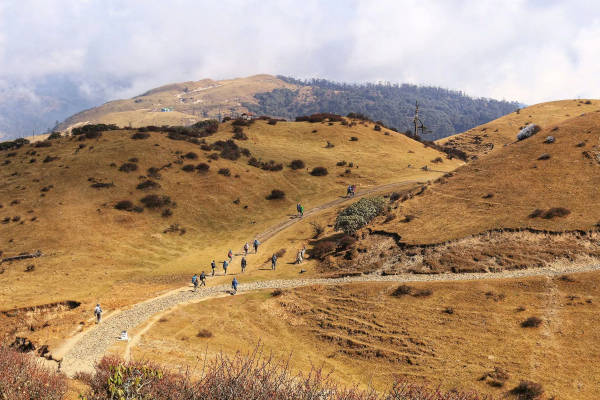
[Meadows, ridges, pastures, boulders. You walk every terrain. Courtesy IndiaHikes]
Day 4: Trek from Molley to Sabargram via Phalut (15 km / 7-8 hours; altitude gain and loss: 11,220 ft to 11,450 ft via 11,810 ft)
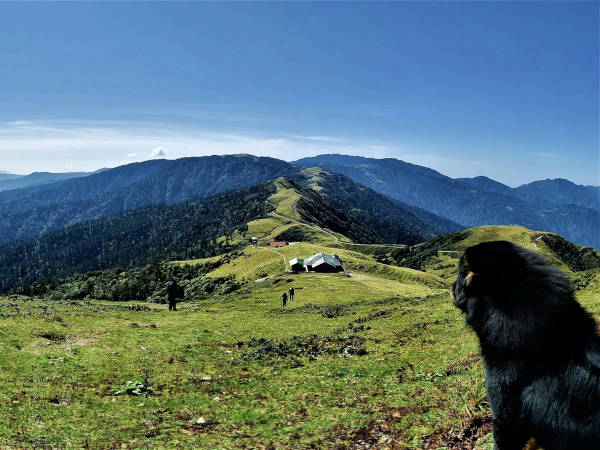
[A 17.5km distance covered on this one day. Can’t complain about the views. And the local Doggos! Courtesy IndiaHikes]
Day 5: Trek from Sabargram to Sandakphu (13.5 km / 7 hours; altitude gain: 11,450 ft to 11,930 ft)
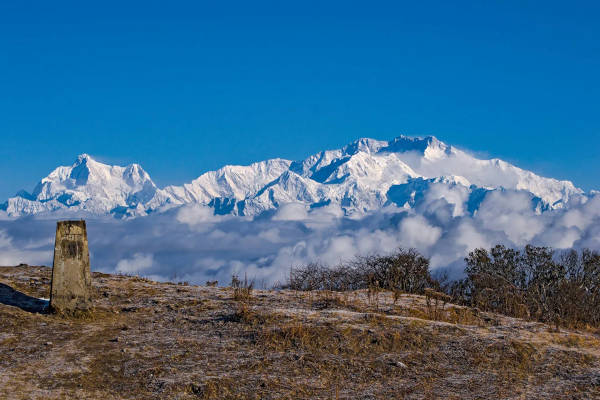
[Nepal territory marker. We just walked across to the next country. Lucky for Indians, no need for a visa.]
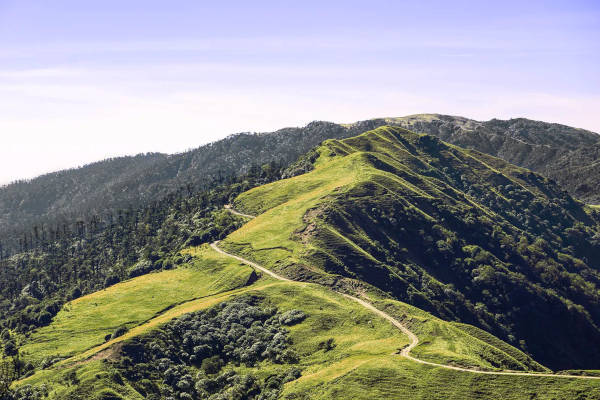
[Can’t get enough of this. Courtesy IndiaHikes]
Day 6: Trek from Sandakphu to Gurdum (8.5 km / 7 hours; altitude gain and loss: 11,930 ft to 7,395 ft)
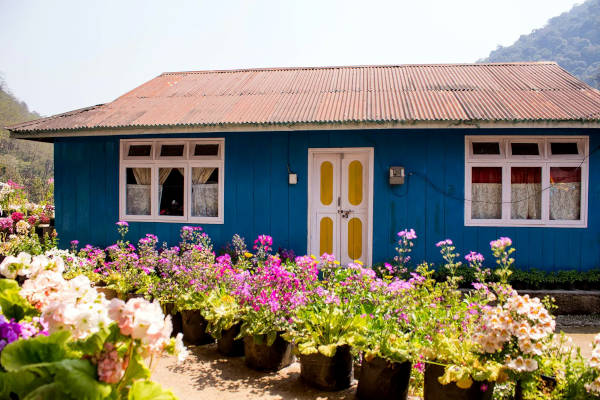
[Picture book perfect homes that brave the weather, winds and greet you with smiles and unreal flowers blooming]
Day 7: Trek from Gurdum to Sepi. Drive from Sepi back to NJP Railway Station / Bagdogra Airport (Trek Distance: 4 km / 3 hours; altitude loss: 7,400 ft to 6,400 ft. Drive distance: 130 km / 7 hours)
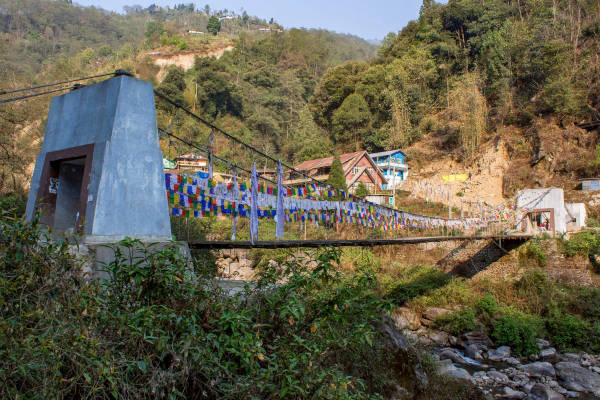
[Srikhola Bridge. On the last day, just the sight of this bridge made me feel bittersweet. Yay for the toilet and my own bed that awaits, but sad that this journey is ending.]
I was so excited in the weeks leading up to the trek—the anticipation of the unknown was fueling my desire to gather as much information as I possibly could. I read blogs. I watched trekker videos on YouTube. I spoke to the IndiaHikes office staff whenever I had questions about my fitness or what to pack! I have mixed opinions on gathering too much information before any trip. I always feel it robs me of the sense of wonder and discovery. But credit to the IndiaHikes website—there is a wealth of information on this trek and I assure you there is very little left unknown prior to the trek.
I knew what to expect mentally. I just didn’t know the reality of what awaited!
I’m doing this week-long trek.
Sikkim Nepal border.
Seven days of trekking.
10 people in my group. Eight strangers, two I knew.
Stay at campsites and tea houses along the way.
Eat hot meals for breakfast. Lunch and dinner cooked by the teahouse owners or at the campsite by the kitchen team.
Simple food, nutritious and vegetarian (yes that was tough for me!)
Summit twice: Phalut (11,810 ft) and Sandakphu (11,930 ft)
Brace for the cold. Day time (first week of March): Between 5 degrees C and 10 degrees C; Night time: Will drop to between 1 degree C and 5 degree C and may feel like -5!
Brace for the winds. Aal tea house especially was the roughest night. No sleep for anyone! It was hard for us to stand still to view the best sunset of my life! And the sounds of the winds like purgatory!
Brace for discovering muscles in my legs I never knew existed.
Brace for many sleepless nights wondering what I signed up for!
Brace for a simpler life.
So what’s the trek like overall?
Sandakphu Phalut holds a special place in my heart, unlike any other corner of the world, especially when it comes to witnessing the first and last light of the day. There's something utterly magical about the sunset at Aal—a spectacle I found myself lost in, time and time again. Despite the crazy winds and not being able to stand still or take my fingers out of my gloves because of how icy cold it felt, I have till date never witnessed a sunset below me. The altitude at Aal was 11,570 ft, so we were actually standing above the clouds!
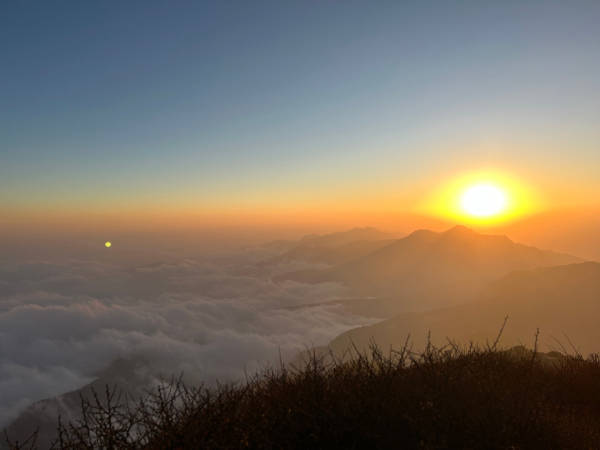
[The most unbelievable sunset ever! This is Aal in all its glory. The icy winds that sweep you off are made up for just by this one view.]
As the day draws to a close, a sea of clouds gently settles below. Amidst this ethereal sea, the sun dips slowly, casting the Everest cluster and the Sleeping Buddha in a soft, glistening orange hue. They call this Alpine Glow. We were lucky the weather gods were kind to us on all days of the trek so we had crystal clear views. It's moments like these, so raw and emotional, that make this trek unforgettable.
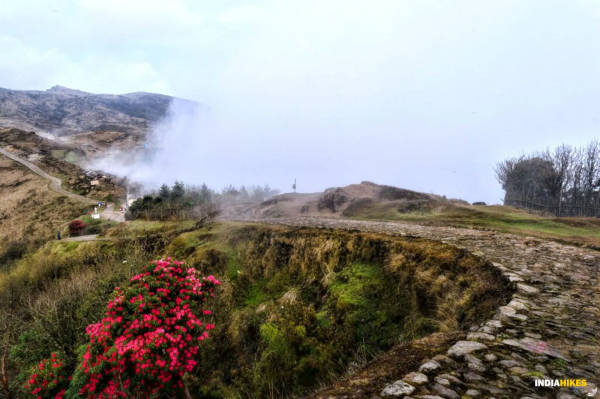
[March is when the Rhododendrons start to bloom. Courtesy IndiaHikes]
Ever since I have come back, I find myself telling my friends and family, “You must experience the sunrises and sunsets here.” No other trek or trip has offered me the spectacle of light that Sandakphu Phalut does. It's as if the sky and the earth conspire to put on a show just for us. It is magic, pure magic.
Venturing through the Singalila National Park is a highlight for many, myself included. I had only ever heard about this in geography class before. One section of the forest we trekked is called the Red Panda zone. Sightings are rare and we were not so lucky!
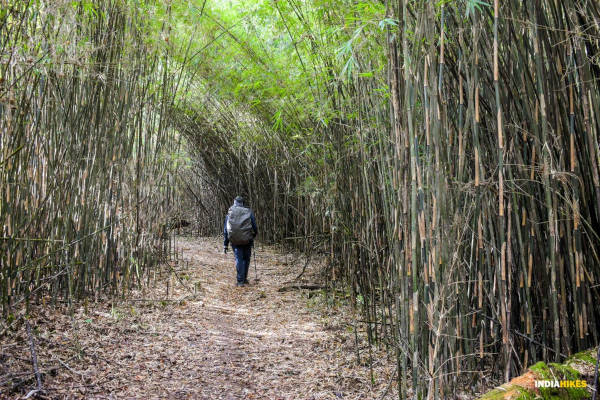
[Trekking through the bamboo section of Singalila. Courtesy IndiaHikes]
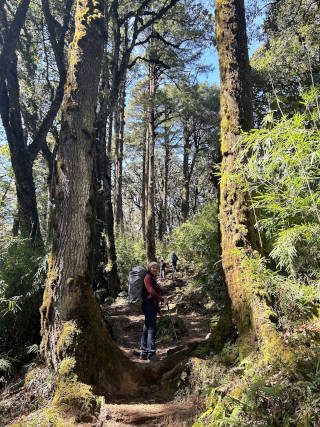
[Bracing for an entire day of ascent.]
The bamboo and rhododendron forests, dense and sprawling, are nothing short of magnificent. Walking beneath the canopy of towering bamboo, where sunlight filters through in a soft green glow, feels like stepping into another realm. And in spring, when the rhododendrons are in bloom, the landscape transforms into a painter's palette of pink, red, scarlet, and white—it's a sight that words do little justice to.
On rare occasions, previous trek leaders have been lucky enough to spot the elusive red panda amidst these woods. While sightings of the Himalayan black bear, red panda, and clouded leopard are rare, they're not beyond the realm of possibility. But beyond the natural wonders, it's the trek's rich Indo-Nepali culture that captivates me the most. The seamless weaving in and out of Nepal, where our sleeping tents stand in India and our kitchen tents in Nepal, adds a layer of intrigue and excitement to our journey.
The cultural tapestry here is vibrant, with the local families running tea houses exuding unmatched warmth and hospitality. Something I have not experienced traveling in India beforehand. A step inside, and you're welcomed with a steaming cup of Darjeeling black tea and a smile that feels like home. The prevalent Buddhist culture, alongside a cuisine that deliciously fuses Nepali and Tibetan influences, adds to the trek's charm. I tried Bhukiya roti, paired with homemade fruit jams, and got a taste of the authentic Nepali Thukpa, a taste of the local life that's hard to forget. And of course, the Dalle Khursani—a chilli that challenges the bravest of taste buds—along with bamboo shoot pickles and Churpi, round off the culinary adventure.
To me, the Sandakphu-Phalut trek is more than just a journey to the Sleeping Buddha. It's a spiritual quest, an immersion into a rare culture, an exploration of unique ecosystems, and a front-row seat to the most extraordinary sunrises and sunsets. It's an experience that stays with you, long after you've left the mountain trails behind.
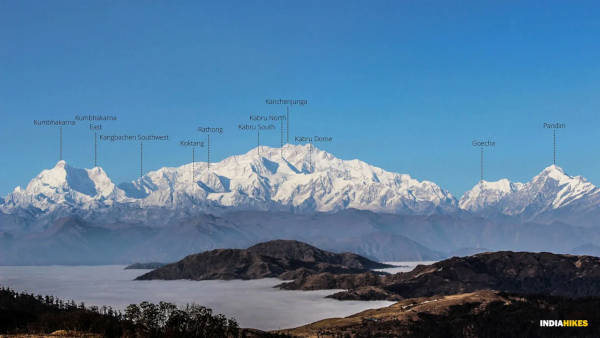
[All that your eyes can take in. Courtesy IndiaHikes.]
How hard could it be?
On a scale of 1-10, 1 = even my 2-and-a-half year old son could do this to 10 = this is for serious mountaineers, I will be honest and say that some days were 4 and some days were 7.5. Ok one day was even 8.5! The days I found the hardest were day 5, 6, and 7. I lost the soles of both my shoes and hadn’t carried a spare. So my trek leader and trek guides saved the day.
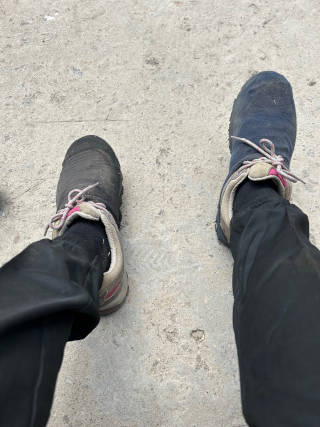
[RIP my trusty Decathlons]
Yes. What you see in the photo is correct. I trekked in this state for approx 35 km! My shoes held together by my own hairbands and my group members donating socks. Aaah Indian jugaad—never lets me down!
Hardship is a state of mind. I thought my biggest worry on this entire trek would be the lack of toilets. I was so wrong! The hardest thing was to conquer my own mind. To silence my own thoughts every time I thought it was too tough, my legs are hurting, who ascends a mountain at almost 90 degrees? It was hard in non physical ways. On the days I was tired, telling myself one more step. On the days I was sleepy, telling myself tonight I’ll be warm and get some shut eye. On the days when I couldn’t take the icy winds on my face for a minute longer, telling myself a hot and humid Bangalore awaits. And how can I forget—the days when changing four layers of clothes inside a tent seemed like the hardest thing to get through, telling myself no one cares if I changed my clothes!
Ironically, while we were trekking this route, the locals were also preparing for the Buddha Trail a.k.a The Hell Race. The Buddha Trail is an ultra marathon in Rimbick, a small sleepy village in the hamlets of Darjeeling. The marathon takes runners on an epic journey up to the Sandakphu Phalut Ridge to witness the stunning Sleeping Buddha of Kanchenjunga Mountain. There are three categories of the marathon: 65km/15hrs; 30km/7hrs; and 12km/2 hrs. Just for your information, the winner of the 10th March 2024 marathon was Hemant Limbu who took just 6 hrs 51 mins to complete the 65km circuit non-stop! Man is a machine!
It’s been a tough one week of being back to the hustle bustle of Bangalore and our daily lives of running businesses, spending time with my son, walking my dogs and eating what I want, when I want, delivered to me within 15 minutes. It’s been tough having an endless supply of water in my taps in all my bathrooms. It’s been tough having hot meals in fancy plates that I don't have to wash up in icy cold water afterwards. It’s been tough sleeping in a comfy bed with the AC on. It’s been tough sitting in an Ola cab to go to the office, covering a mere distance of 8km in one hour of legendary Bangalore traffic. It’s been tough telling my friends that I went to the Spa in Darjeeling after my trek just so I could walk like a normal human again. It’s been tough coming to terms with the world I left behind in those quaint, charming, rustic and happy villages of Sepi, Sabargram, Moley, Aal and Gurdum. Slow living, bright happy homes adorned with colourful flowers. Every person you see along the way greets you in Nepali and asks how you are faring. I can’t even remember my neighbours’ name in Bangalore, let alone stopping to ask them how they are doing. We even tasted local rhododendron wine. I liked it a lot! It was a bit like a Himalayan Bacardi breezer.
It’s been tough coming to terms with the version of me after the trek. The version of me which is desperately trying to silence the noise inside my head. The one that has been asking me “Why are you complicating life so much”?, “Why is everything done at such a hurried pace?”, “Why do you watch TV while eating dinner?”, “Why are you struggling so much to adapt back to the life you lived on autopilot?” … ”What are you missing the most about the seven days that you just experienced?”
I think I am coming to terms with the answers.
I liked not having a phone to answer.
Not having to talk to so many people all day long.
I liked being on my own.
I liked having huge mountains to stare at. They have nowhere to go, just to be. Like they have been for centuries.
I sat one evening at the Sabargram campsite and just stared at the mountains. Suddenly all the noise from my head went quiet. I just shut down internally. I guess the surroundings do that to us city folks—dial everything down many notches. I can’t describe that feeling. It was very calming. I guess I was “in the zone”.
I liked the feeling of being insignificant, tiny and inconsequential in the largeness of the Himalayas.
I think at age 36, I needed this trek.
I needed it to remind me of all the 1000000000 little things that take up room in my heart.
And that those are the real things in life that make it worth living.
It was not the mountains that were calling me.
It was me calling them out.
And then it all made sense. Every IndiaHikes poster I saw at every campsite and teahouse had one same message. I get it now.
“Everyone must trek. Trekking transforms lives.”
More information on Sandakphu Phalut
The trek organiser: IndiaHikes
Best time to go: March. It is Springtime and the forests are lush green, full of flowers and fallen leaves. Just picturebook perfect. Rhododendrons are flowering!
Trek fee: Rs 12,950 (excluding tax). One amazing thing about IndiaHikes is that any trek you do with them, even if you were unable to complete it, that trek is FREE for your lifetime. They do this to encourage the spirit of trekking—such a unique concept!
Expenses for the trek: Excluding airfares and hotel accommodation in Darjeeling pre and post the trek, you’ll spend anywhere between Rs 20,000 and Rs 30,000 per person on the trek and allied expenses (like car rental to basecamp and back, extra food, bucket of hot water (!), offloading luggage onto mules—these are spare clothes and other unnecessary items like headphones, tripod etc you probably won't need on the trek.
Gear you need: IndiaHikes has every equipment you could possibly need available for rent. Unless you are a trekker and own shoes, backpacks and other equipment already, my recommendation is not to invest in new gear. Rent from IndiaHikes instead. PS: I wish I had rented a spare pair of shoes for myself!
Fitness preparation before the trek: Run/jog at least 5km in 40-45 minutes or cycle 30km in 40-45 minutes. I used to listen to podcasts to take my mind off this lofty goal. I cycled two-three times a week.
Editoe's note: You can read Shailesh Kochhar's experience of the trek here.

